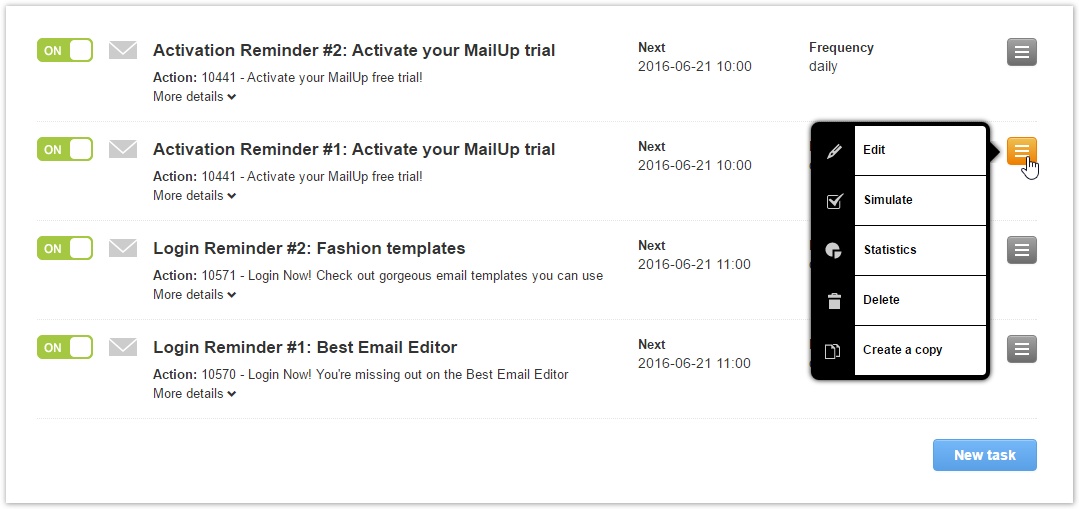Introduction
Tasks are a powerful feature...
that takes your email and texting marketing business to an advanced level.You can set the rules with extreme precision, choosing the days and recurrences you prefer, with non-disturbance bands and support for different time zones. In addition, you can choose the activation frequency (with a minimum of 5 minutes and a maximum of 12 hours).
You can use Tasks to achieve three actions:- To send an email;
- To send a SMS;
- To segment your customers by assigning them to a group or moving them from one group to another.
Practical examples of use
You can create messages that
...
are automatically sent when certain conditions occur
...
and specify when
...
these conditions should be checked.
...
For instance:
- You can check once a week
...
- if a user has not opened an email message for
...
- three months
...
- and send
...
- him a
...
- re-engagement
...
Generally speaking, you can use tasks to do three things:
- Send an email automatically
- Send a text message automatically
- Segment your customers automatically assigning or moving them from one group to another
...
| title | Workflows and tasks: how to use them both |
|---|
...
- message;
- You can set up automatic sending of emails or SMS upon the occurrence of conditions such as registration, purchase, variation of a value in the registry;
- You can send an email indicating the publication of a new post on your blog;
| Note | ||
|---|---|---|
| ||
Note: if you create a Task with the same starting conditions as the first message of a workflow, the workflow may never start. To avoid this situation, you |
...
need to create either a workflow or a task to send a message when a certain condition occurs, not both. |
...
Of course, you can use |
...
Workflows and |
...
Tasks at the same time when they serve different purposes, |
...
but not when the purpose is the |
...
Here are some examples of when tasks could be used.
Re-engagement campaigns
Email marketing campaigns devoted to re-engage recipients that have become "idle" - for whatever reason - are becoming a more and more important part of a good email marketing strategy. Tasks allow you to automatically attempt to re-engage customers that have not clicked or opened messages, and either re-engage them or ask them to unsubscribe.
Post-signup marketing
Many businesses leverage triggered messages to automatically follow-up with customers who sign up for their service, whatever the service may be (e.g. a Web application, an online magazine, etc.). The post-signup messages could be sent to inform new users of how to best take advantage of the service that they just signed up for, or to re-engage users that have not logged in, etc.
Post-purchase marketing
An eCommerce store - maybe using an eCommerce system that has been integrated with MailUp - can leverage data stored in one or more Recipient fields to send targeted campaigns to customers. For instance, a discount 60 days after the last purchase, or a "Thank you" coupon to those that purchased more than $500 in the last 12 months.
...
same. |
Related pages
| Child pages (Children Display) |
|---|
